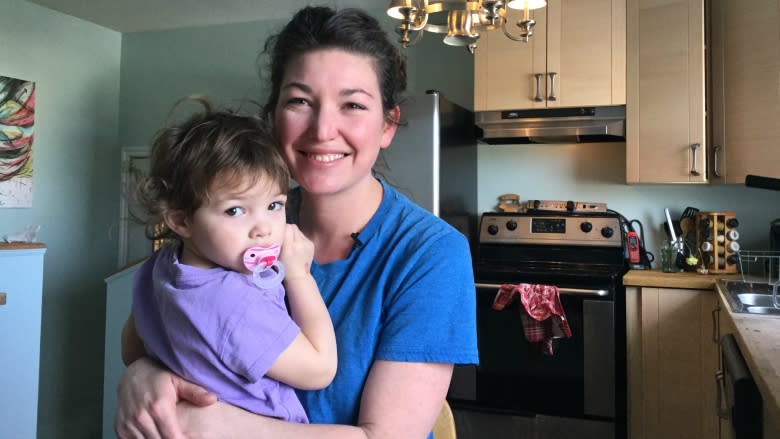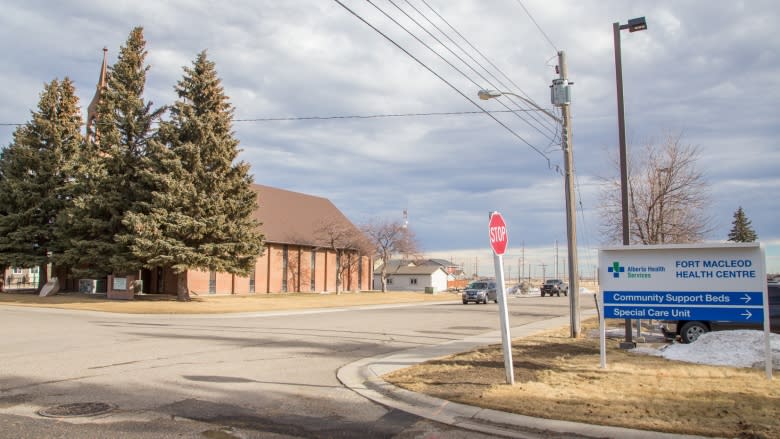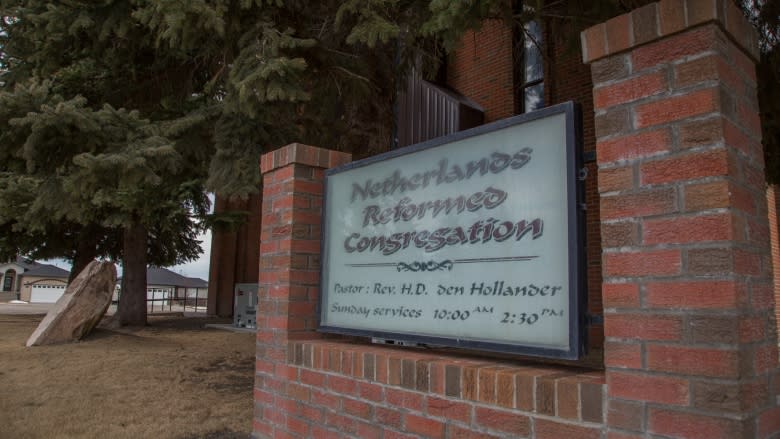Why these 2 small towns in southern Alberta have vastly different vaccination rates
This story was originally published Feb. 21, 2017
Erin Henderson's kids are among a minority in and around the southern Alberta town of Fort Macleod — they've been immunized against polio.
The mother of four made the decision to take her children for the recommended immunizations after researching the benefits and risks of vaccines, including the so-called "five-in-one" shot.
That one protects against tetanus, diphtheria, whooping cough, polio and one of the most common forms of meningitis, but only 46.5 per cent of children in the area have received a full dose by age two, according to Alberta Health data.
- Want to know the immunization rate in Alberta communities? Scroll down for an interactive chart.
"It's definitely concerning," Henderson said of the low rate.
"I mean, people die from these diseases. You don't want to put your kids at risk for that."
While the incidence of such diseases is rare in Canada, the concern is real among many parents in southern Alberta.
Outbreaks are relatively frequent in that part of the province, and in 2012 a baby girl died from whooping cough at the age of one month — too young to be fully immunized against the disease.
While immunization rates are relatively low across the region as a whole, they can vary widely from one town to the next.
The Fort Macleod area, for example, ranks nearly dead last out of 132 local health zones in Alberta, but the neighbouring community of Pincher Creek — immediately to the west — ranks among the highest.
The two towns are just 50 kilometres apart and the surrounding rural areas border each other.
So what's behind the big difference?
Henderson has a theory — one shared by others in the community who aren't as willing to talk about it publicly, because it can be a sensitive topic in Fort Macleod.
"There's a large religious community here," she said.
"We're kind of in the Bible belt. And I think there are strong religious views about it, so a big portion community decides not to vaccinate."
The name of one particular church — the Netherlands Reformed Congregation — often comes up when talking about vaccinations in the Fort Macleod area.
It's a small sect but one that's connected to the large Dutch community in town. Its leaders have been known to describe vaccinations as a sort of interference with God's will.
The same church made headlines in British Columbia during a 2014 measles outbreak in the Fraser Valley that was traced back to unimmunized congregation members who had picked up the disease while visiting the Netherlands.
"It's a very socially tight-knit group, the Netherlands Reform community," said Dr. Vivien Suttorp, the lead medical officer of health for southern Alberta, speaking to a physicians conference in 2014.
During that conference, she explained how the 2013 measles outbreak near Fort Macleod was also traced back to an unimmunized infant who had travelled to the Netherlands.
Suttorp, who happens to have grown up in the Netherlands and speaks Dutch, said she declared the outbreak after that single case was confirmed.
Public health officials then kicked a protocol into gear that had been developed with local religious leaders and schools — a sort of deal under which those groups who choose not to immunize agree to take on the responsibility for isolating and quarantining people at the first sign of an outbreak.
"We immediately that afternoon, once it was confirmed, engaged with schools," Suttorp said.
"I had a teleconference with all those schools, saying OK, measles is here now. But they already all knew what to do. … I communicated also with the church leaders. I had a teleconference at 4 o'clock on a Friday afternoon telling them measles is here."
CBC News tried to contact the pastor of the Netherlands Reformed Congregation in Fort Macleod by phone, email and ringing the doorbell on the church door, but received no reply.
Of course, isolation was just the first step in dealing with that outbreak.
Doctors, nurses and public health officials quickly descended on the area and set up an emergency operations centre. Suttorp said they built mobile measles assessment centres and in some cases drilled holes in concrete walls to build negative pressure rooms, which didn't exist in the region.
In the end, the outbreak was contained to 42 confirmed cases among just 12 families. Suttorp said it could have been much worse if it weren't for the quick, initial actions of the unimmunized community members.
"The expectations of the cultural leaders became the norm: If you do not immunize, you quarantine and isolate," she said.
"We didn't have to tell people to isolate or quarantine. They were just doing it."
Strategy 'somewhat frustrating'
Tim Caulfield, research director of the Health Law Institute at the University of Alberta, has mixed feelings about the strategy of working with unimmunized communities on reactive measures and tacitly accepting their refusal to help prevent outbreaks in the first place.
"I find it somewhat frustrating they have to take those steps; ideally you want the vaccination rates to go up," he said.
"But if you know that isn't going to happen, I think it's worthwhile to have protocols in place to address it. It's a sensible step."
Caulfield, the author of Is Gwyneth Paltrow Wrong About Everything?, a best-selling book on celebrity culture and pseudoscience, described the disparate immunization rates in Fort Macleod and Pincher Creek as a "wonderful example" of how complex the phenomenon of vaccine hesitancy can be.
"We know from research this is not just a simple issue of getting people the facts," Caulfield said.
"There's a lot more going on, and that includes culture and that includes community and that includes personal values."
Dr. John Rottger, who practises rural family medicine in the Pincher Creek area, said religion is just one of the factors at play in the different attitudes toward immunization in his community compared to nearby Fort Macleod.
The influence of social media can also amplify the individual and collective viewpoints of vaccinations, he said.
"If you have a personal belief system, you can find any information you want on the Internet to support your view," Rottger said.
'Cultural norms'
The influence of what others in a community are doing can also have an impact on parents' decisions.
"We can't underestimate the cultural norms," Suttorp said in her presentation to physicians.
"Some families will move to southern Alberta and the four older children are immunized but the younger ones who have been growing up here are not."
Robert Bednarczyk, a professor of global health and epidemiology at Emory University in Atlanta, Ga., said he's seen similar things in the United States.
"If you have communities that may have certain perceptions around vaccines, that may spread within that community and further reinforce some of those beliefs," he said.
'It's about all the children'
Juliet Guichon, a medical bioethicist at the University of Calgary, said parents have a right to follow a religion's tenets but they also have a duty to keep their children alive at least long enough so that they can make their own religious and medical decisions.
She also noted that 85 per cent of a population needs to be vaccinated to provide "herd immunity" against some diseases for infants who are too young to be vaccinated and older children and adults who can't be effectively immunized due to allergies or compromised immune systems.
"Those are the people who are protected when the herd is protected, so there's an important public benefit that individuals should consider when choosing whether to vaccinate their children," she said.
"It's not just about their children; it's about all the children."
Guichon said it's unfortunate, in her view, when religious leaders offer medical advice that runs contrary to scientific evidence, and it's also "ironic" in this case because Antonie van Leeuwenhoek, commonly known as the "father of microbiology," was Dutch.
"He had an originating role in helping identify microbes that eventually led to vaccination," she said.
"So I don't understand why the Dutch Reform Church does not embrace the heritage that is their own heritage."
Caulfield said it's "really hard" to convince people to change their minds about things like vaccination, but it can be done with a combination of evidence, empathy and tailoring the message to address varied and nuanced concerns.
"Not everyone is a hardcore antivaxxer," he said. "People's beliefs and concerns about vaccination fall on a contiuum."
Of course, in his view, Caulfield said the evidence in favour of vaccination is "overwhelming."
"The bottom line is vaccinations are one of the single most successful science and health breakthroughs in human history. That's not hyperbole. The lives — the millions of lives — that vaccination has saved is something that needs to be celebrated."
The interactive table below shows childhood coverage rates for five different vaccine types, by community, in Alberta.
Click on the headers to sort by community or coverage rate. (Please note there is a known glitch on some devices that, when sorting some of the fields from largest to smallest, the smallest value appears at top.)
Use the search box to look for a specific community. Scroll to the bottom for data notes and a link to download the data.






